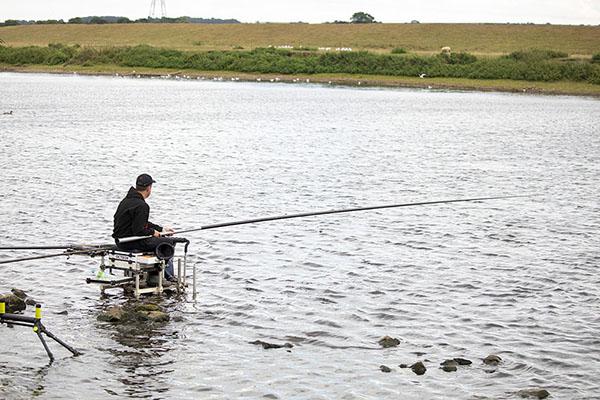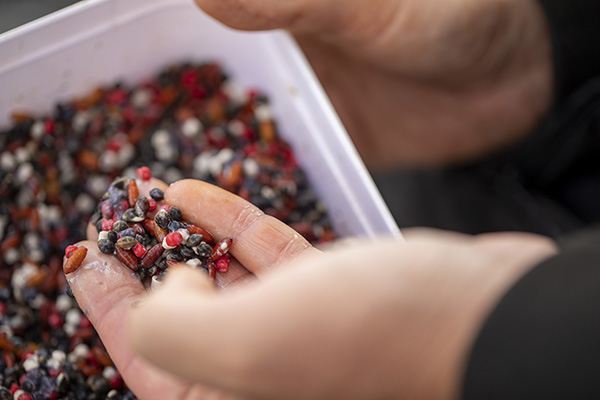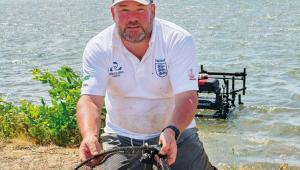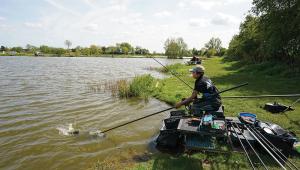Pole Fishing On Rivers - Tom Scholey

When it comes to big river fishing Tom Scholey takes a super-confident small fish approach to maximise his chances of success.
Balling in groundbait. There can’t be many things that we do as match anglers that are as exhilraing. Unleashing a salvo of bait that can be heard for miles around, then proceeding to haul out large roach and dace that have been instantly attracted to the commotion!
I have learned a lot about this style of fishing over my years as a river angler, and won a fair few quid too, so hopefully I can pass on a few tips to help you get the best from the technique.

It all started for me back in the Summer of 2010. I was a young, fairly green reporter working for Pole Fishing Magazine and I had been asked to cover the Team Match on the Evesham Angling Festival. The river (as always) was really difficult with weights of three to 4lb worth good points.
At this time, I had hardly done any natural venue fishing at all, and I stood on the town bridge staring upstream wondering what was happening as the competitors unleashed ball upon ball of groundbait on the river.
I was shocked. With commercial carp and F1s swimming around in my head, I honestly didn’t think that any of the competitors would get a bite, it just didn’t seem quite right.
Feeding four kilos of bait to catch two kilos of fish? But low and behold anglers caught instantly and good stamp fish too. From memory, everyone who did well that day caught after balling in. And so my fascination with this style of fishing was born.

Feed Well Downstream
I learned one of my biggest ‘balling in’ secrets at Evesham from Rob Perkins, and that was to do with where the groundbait is thrown. This is such a simple, but deadly edge with this technique, and something that so many anglers ignore. To many, it seems logical to throw in groundbait in front of you, or even slightly upstream. After all, it gets washed downstream with the current, right? WRONG!
Groundbait rarely washes as far as you think and the main problem with having fish bang in front of you on a river, is that it is very difficult to catch them on a running pole rig. After all, the rig needs time to settle in the flow before it reaches your bait. Feed too far up your peg, and you find yourself missing out on fish.

So the first key lesson here is always feed well downstream. I generally look around 1 or two o’clock on a clock face if it’s flowing to my right, or 10 or 11 o’clock if it’s flowing the other way. Keep in mind that the lightest rig you set up needs to be working (all shot registering on the float) before it reaches your bait.
I can’t stress this point enough, as it is one of the most common mistakes where balling in is concerned. Often, you find that the biggest fish you catch are just as you run on to your bait - which shows just how vital it is to get this right.

The Right Mix
So what groundbait mix should you use? Firstly, I must say that there is no golden rule here, it is all very much about personal preference. Four key groundbaits come into it for me. Dynamite Frenzied Hemp Black goes in all my mixes because roach just love it, plus it darkens every mix beautifully.
On slow moving rivers I will add Sensas Lake then depending on the pace, I might also add Gross Gardons. On really pacey water, I will replace the Lake with Sensas River. When roach and dace are the target, I also add Crushed Hemp to the mix. I soak 500mm of this in boiling water overnight, then add it to the dry groundbait before mixing and this is a deadly edge at times.

Just as important as the mix that you use is how you mix it, and again I think this is something not enough anglers pay attention to. We all love the aesthetic of a dry mix, it just looks right doesn’t it, beautifully crumbly and breaks up quickly in the water.
Again, this is one of the most common mistakes I see anglers make though - use too dry a mix and you will ruin your swim because you end up bringing fish off the bottom, or worse actually pushing them out of your peg. There are a couple of exceptions to this though. For example, if I was fishing for small fish on a very slow moving river, an active mix might be nice, but on anywhere with any flow, I like a bit of a stodge. This means mixing the groundbait at least three hours before the session and giving all the particles a chance to absorb the water. You want it to be damp enough so that you can squeeze it together easily, and the harder you squeeze it the harder the ball becomes.

I then vary the consistency of my balls, so some are squeezed as hard as I can make them, and some are made to just hold together. I am looking to make sure my bait goes to the bottom intact and stays there, breaking up and releasing feed at a steady rate throughout the early part of the match.
In practice, this means you get quicker bites and catch bigger fish, because there is less ‘open food’ (from the broken down groundbait) in your peg at any one time, so the competition among the fish that are present is greater.
The Right Particles
The third dimension to this is the loose particles that you add to your initial mix, and then how you loosefeed throughout the day to keep fish coming. A key tip here is to bring a wide variety of baits with you from dead pinkies and maggots to casters, hemp, worms and Fjuka micros, I really like to cover my options as much as possible.

It may seem a faff at the start of the session, but by building your peg in this way, you give yourself more hookbait options later and often ringing the changes between baits and presentations is the key to keeping fish coming through the session.
Although I like to vary the content of my initial feed, I am always careful not to feed too many particles, especially when I expect the sport to be tricky. For today’s session at Burton Joyce I am confident of a few fish, but I still have only put 300ml of particles in 12 balls for my initial feed.

Again, competition is at the forefront of my mind here, I never want too much bait in my peg at any one time. I can then control the fish by loose feeding through the day.
Make A Parti-Mix
When it comes to loosefeed I have two key approaches, which I vary depending on what my peg tells me. The first is just loose feeding hemp - and this is brilliant when there are a lot of small fish like dace present, as hemp tends to bring in the better quality dace and roach.

The other is to make what I call a ‘parti-mix’ where I mix a few different baits and feed them together. Today, I have mixed casters, hemp and white and black Fjuka micros in a tub. The main advantage this gives you is you can feed a variety of particles quickly, so you can ship out, drop your rig in then fire in a single pouch of bait with a variety of particles in, before returning your attentions to controlling your rig as your run it down your peg - it speeds things up, and means you can concentrate on putting your float through.
Rig Up Right
I’m not going to talk too much about rigs here, as again so much of this is to do with personal preference. The key point I do want to make though is you need to cover your options, so you can present a bait in a number of different ways.
You need to be able to vary your presentation throughout the day to fool wary fish and keep bites coming. So for me today, I am geared up to fish everything from a strung 4x16 Chianti at the lightest, to a bulked down 6g flat float for inching a bait through very slowly. I also like to set up a bolo or a stick float where possible, to give me the option of following fish down the peg if necessary.

As with any type of fishing when catching a number of fish is the target, elastic choice is vital. For me a single No6 Preston Slip set softly is the usual choice. This is beefy enough to allow me to set the hook when striking through big floats, and also allow me to get fish in and away from any pike that might be in the area.
Feel Your Way In…
When balling in groundbait, I almost always have the intention of fishing the one line for all or much of the day. For sure, I always like to start on the line as this is when you can capitalise on the instant attraction that the initial bombardment of bait brings. It is then about letting the peg tell you what you need to do to keep fish coming and using this insight to inform your choices.

For today’s session I am sat halfway along the Nelson Field at the beautiful Burton Joyce on the River Trent, controlled by Ashfield Anglers. I am treating the day as a practice session for the forthcoming Angling Trust RiverFest Final, which I was lucky enough to qualify for earlier in the year.
As expected, my initial salvo has bought speedy results and some good fish are soon gracing the net. I am catching fish right under where my groundbait has settled, which tells me the fish are feeding aggressively. As the session develops two things become apparent.
Firstly, the dace love my groundbait! When action slows, I simply top up with a ball and the fish are right back on it. Secondly, there are some better roach present too, but these are hanging further down the peg away from the groundbait.

With this in mind, I begin to loosefeed my ‘parti-mix’, with a view to catching these bigger fish further down my peg. This works a treat and several good roach join the plethora of dace in the second hour. Still baits, like Fjuka micros and casters, work a treat for these bigger fish and I am already thinking it might be wise to cut out the parti-mix and just fish hemp and Fjuka.
I often use black Fjuka Micros on the hook when loose feeding hemp as it is quicker to hook and, being softer, you seem to hit more bites on it.
Although I get fewer bites on this tactic, when I do get a bite, it is from a quality roach. As a match angler, it is now about working out whether it is worthwhile being selective and waiting longer, or if a greater weight can be caught by shipping back the smaller dace quicker on my original tactics.

I have worked out the fish that are there to be caught and am able to choose whichever path I think will give me the biggest weight while keeping my options open.
Learn Your Lessons
Pleasure fishing has its disadvantages as a match angler, especially when it comes to aggressive styles of fishing like this, and this is the final piece of advice I want to get across in this article. It can be very easy to get a false impression from a fish filled practice session and then up your approach and make a mess of things come match day.
If you are pleasure fishing and choose to ball in groundbait, you will most likely pull in every fish that wants to feed within 100 metre radius. On match day, there will be five other blokes in that same space doing the same thing!

The main things I have learned from the day are the fish that are present and how they respond to bait, which does give me a fair head start come match day. I know there are plenty of dace present, as well as some good stamp roach so by feeling my way in feeding wise, I can make the most of whatever fish are in front of me.
Footnote: Two weeks after shooting this feature, Tom went on to win his section on both days of the RiverFest Final, using these same ‘balling in’ tactics.

- Log in or register to post comments












